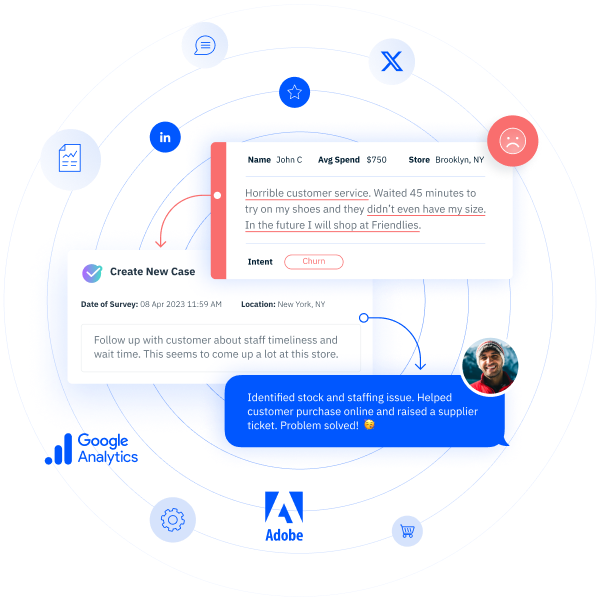16 Best Practices To Improve Customer Experience (CX) in Call Centers
These CX best practices help call centers deliver better service through empathy, smart technology, and a more personalized customer journey.
Your call center has the power to shape how customers feel about your brand. Every interaction, whether it’s handling customer inquiries, resolving complaints, or acknowledging compliments, is a moment that can build trust or break it. And in a fast-paced environment, it’s not just about speed. It’s about delivering a contact center experience that balances efficiency and empathy.
If you’re seeing low customer satisfaction scores (CSAT), rising call abandonment, or more negative feedback than usual, it’s time to reset. The strategies below offer practical ways to improve customer satisfaction, reduce inefficiencies, and deliver a better customer experience without overloading your support team.
1. Use Conversational Intelligence To Uncover CX Gaps
The surest way to improve customer experience (CX) is to solve real customer problems. Conversational intelligence (CI), powered by artificial intelligence (AI), helps you do just that by analyzing interactions to uncover pain points, friction, and customer frustration.
It also highlights where your team may be missing the mark, giving you the insight you need to coach agents more effectively and improve future conversations.
2. Train Agents for Empathy and Active Listening
There’s more to delivering good customer service than solving problems quickly. Agents also need to know how to build trust and connect with customers, and that starts with soft skills.
Focus your training on empathy, active listening, and patience, even during tough conversations. Encourage help agents to acknowledge frustrations or concerns, paraphrase what they hear, and respond with clear, helpful solutions.
Empathetic communication can turn a difficult moment into a trust-building experience that brings customers back.
3. Personalize the Customer Experience
81% of consumers prefer brands that offer personalized experiences. And 88% say the experience itself matters just as much as the product. In other words, personalization has a direct impact on how people choose where to spend their money.
Ditch rigid, generic scripts in favor of conversations that reflect each customer’s history and preferences. One way to make this easier is by connecting your customer relationship management (CRM) system with your CX software, giving agents instant access to relevant details during every interaction.
Personalization shows customers they’re seen and valued, which goes a long way toward building trust and improving customer retention.
4. Reduce Hold Times With Smarter Call Routing
With 70% of Americans choosing a phone call as their go-to for customer support, your call center is often the first and most important touchpoint.
Long wait times and multiple transfers are quick ways to frustrate callers. Instead, use intelligent routing systems that connect people to the right department based on their needs and your agents’ skills. If there’s a delay, set clear hold-time expectations or offer a callback option.
Respecting callers’ time helps reduce friction and leaves a stronger impression of your brand.
5. Improve First Contact Resolution (FCR)
Customers don’t want to call back multiple times to solve the same issue. That kind of back-and-forth quickly leads to frustration and can make your call center customer service team seem unprepared.
Start with thorough training to ensure agents know your products inside and out. Give them access to internal knowledge bases during calls and encourage confident, real-time problem-solving to reduce transfers.
When agents resolve issues on the first try, it leads to positive experiences, stronger customer satisfaction, and fewer repeat contacts.
6. Offer and Optimize Self-Service Options
Not everyone likes to speak to a live agent. In fact, 67% of consumers say they prefer self-service over direct interactions.
Build out helpful resources like knowledge bases, FAQ pages, and online help centers. Make sure they’re easy to navigate, address common pain points, and actually help customers solve problems without needing to call in.
The easier it is for people to help themselves, the better their overall experience and the lighter the load on your support team.
7. Monitor and Act on Customer Feedback
Customers can be your greatest asset in the effort to improve your organization’s CX, but only if you’re listening.
Use post-call surveys to gather feedback on what’s working and what needs improvement. Then, take action. Use those insights to adjust policies, refine training, and close the gaps that impact customer experience.
Turning feedback into meaningful change shows customers you’re paying attention—and that builds long-term trust.
8. Automate QA Scoring
Automating quality assurance (QA) scoring with a tool like InMoment gives you a clearer, more consistent view of customer interactions.
It helps surface inconsistencies, uncover agent training opportunities, and optimize how your team shows up on every call. Automated scoring also allows you to review a much larger volume of conversations and removes human bias from the equation, making your customer insights more reliable.
With the right system in place, you can track sentiment, spot trends, and make smarter CX decisions at scale.
9. Provide Ongoing Coaching and Quality Assurance
Consumer needs, preferences, and pain points are constantly evolving, so your training shouldn’t stop after agent onboarding.
Use surveys, call recordings, emails, and other touchpoints to identify where agents are thriving and where they’re struggling. Then, tailor your coaching to match your findings. If agents are having trouble with difficult conversations, prioritize soft skills like empathy and de-escalation.
Ongoing coaching can help keep skills sharp, build agent confidence, and help your team deliver stronger experiences across every customer interaction, potentially improving CSAT scores.
10. Make Your Support Channels Work Together
Customers don’t always start with a phone call. They might reach out to your brand through email, social media, or even SMS before connecting with a live agent.
To give them a better experience, focus on omnichannel consistency. If someone starts a conversation with a chatbot and later calls in to speak with a human, your agents should have access to that earlier conversation for context. This helps you avoid redundant back-and-forth, reduces frustration, and helps your team deliver faster support.
Aligning your channels leads to smoother interactions and smarter CX optimization.
11. Equip Agents With Integrated Tools
Disconnected systems slow customer service agents down and make it harder to streamline support. When they have to jump between platforms just to answer a question, it creates delays and unnecessary friction.
Integrating your CX software with tools like CRMs and feedback platforms gives agents a holistic view of each customer’s journey and sentiment. That context improves service quality and makes it easier to address customer issues quickly and effectively.
With the right tools in place, reps can spend less time switching tabs and more time solving problems.
12. Set Clear, Customer-Centric KPIs
Key performance indicators (KPIs) help you track whether your CX optimization efforts are working and where to adjust.
Balance efficiency metrics like average handle time with customer-focused indicators like customer effort score (CES), net promoter score (NPS), CSAT, and first contact resolution. These numbers give you a clearer view of how customers actually feel about their experience.
If the data points to positive progress, keep going. If not, adjust your strategy using insights from conversational intelligence and direct customer feedback.
13. Communicate Proactively With Customers
When issues come up—like service disruptions or product delays—don’t wait for the complaints to roll in. Proactively reach out to let customers know you’re aware of the problem and working toward a resolution.
This kind of communication can ease concerns, reduce your call center’s inbound call volume, and help lower wait times for other customer support tickets. More importantly, it builds trust by showing customers you’re in control and paying attention.
14. Celebrate Agent Wins and Promote Engagement
While it’s important to address areas where call center agents may be struggling, focusing only on what’s going wrong can hurt morale and lead to burnout. Recognition matters.
Make space to celebrate wins. Reward agent performance with incentives like gift cards, team shout-outs, or spotlight features for those who go above and beyond. Recognize the reps who consistently exceed customer expectations, and let others see what great service looks like in action.
A culture of appreciation improves the agent experience, supports retention, and motivates the entire team to keep raising the bar.
15. Address Systemic Issues That Drive Negative CX
Not all negative CX stems from call center agents. Broader issues, like faulty products, unclear company policies, shipping delays, or complicated purchasing processes can just as easily erode customer trust.
Use conversational intelligence software to identify recurring pain points and understand what’s really driving customer dissatisfaction. Then, take direct action to fix the root causes. For example, if shipping delays are a frequent complaint, work with your logistics provider to improve delivery timelines or explore other partners.
Fixing these systemic issues improves future experiences and shows customers that your business listens and follows through.
16. Continuously Iterate Based on Data
As customers’ needs and expectations evolve, your CX optimization efforts should evolve with them. Regularly review customer data from surveys, agent-customer interactions, and KPIs to spot what’s working and where you can improve.
Small, consistent changes based on real insights can help your customer service team stay responsive and aligned with what your audience values. Ongoing CX reviews and experimentation not only improve satisfaction but also strengthen retention over time.
Improve Your Call Center’s Customer Experience With InMoment
Excellent customer service experiences can increase customer satisfaction, strengthen loyalty, and reduce churn. To enhance CX, use conversational intelligence to identify experience gaps, offer regular agent training focused on both hard and soft skills, act on customer feedback, ensure consistent support across communication channels, and recognize standout agent performance to keep motivation high.
InMoment’s integrated CX intelligence platform helps improve the call center experience by delivering rich customer insights. It captures customer feedback, surfaces common challenges and CX trends through conversational intelligence, and supports data-driven action plans to strengthen your overall strategy.
Schedule a demo with InMoment today to see how our platform can power your next stage of CX optimization!





